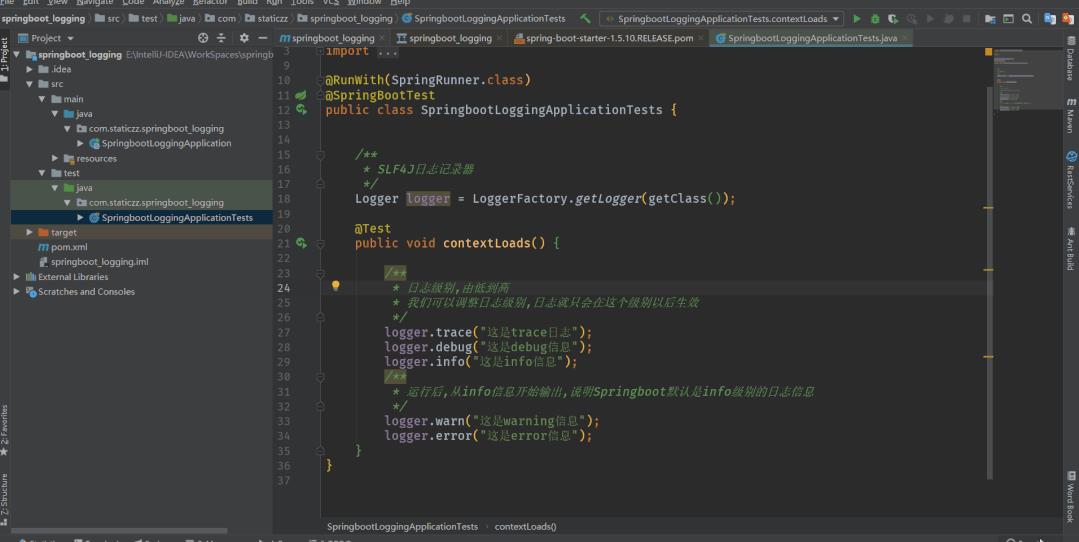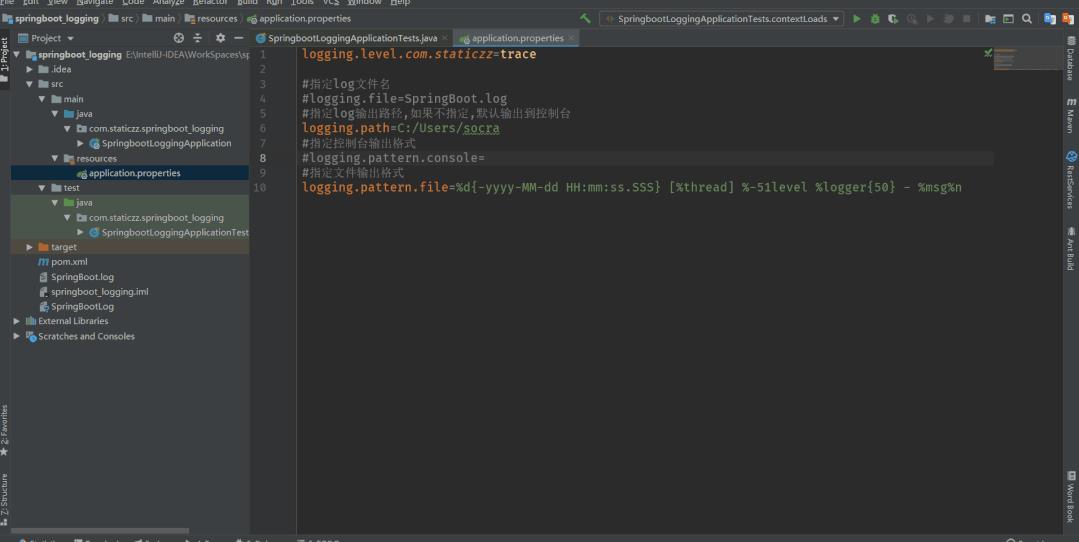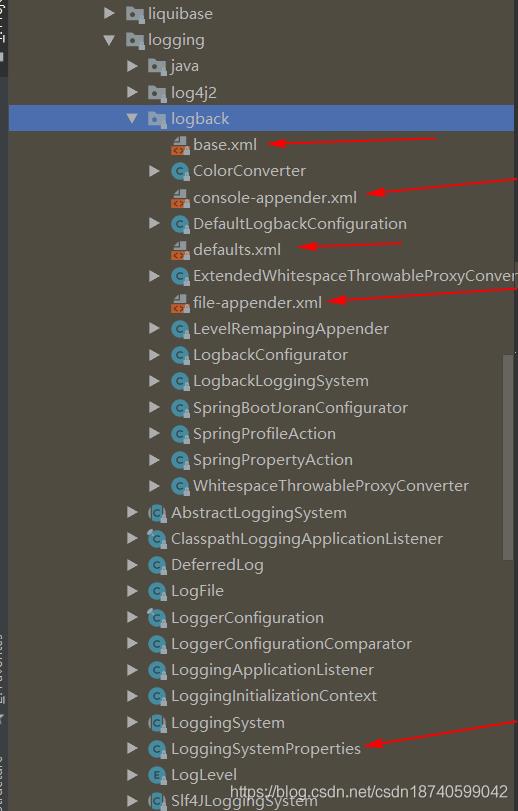SpringBoot默认日志配置输出级别
Posted Java知音_
tags:
篇首语:本文由小常识网(cha138.com)小编为大家整理,主要介绍了SpringBoot默认日志配置输出级别相关的知识,希望对你有一定的参考价值。
点击关注公众号,实用技术文章及时了解
来源:blog.csdn.net/csdn18740599042
/article/details/109031005
Springboot默认配置
我们在测试类中来进行演示
package com.staticzz.springboot_logging;
import org.junit.Test;
import org.junit.runner.RunWith;
import org.slf4j.Logger;
import org.slf4j.LoggerFactory;
import org.springframework.boot.test.context.SpringBootTest;
import org.springframework.test.context.junit4.SpringRunner;
@RunWith(SpringRunner.class)
@SpringBootTest
public class SpringbootLoggingApplicationTests {
/**
* SLF4J日志记录器
*/
Logger logger = LoggerFactory.getLogger(getClass());
@Test
public void contextLoads() {
/**
* 日志级别,由低到高
* 我们可以调整日志级别,日志就只会在这个级别以后生效
*/
logger.trace("这是trace日志");
logger.debug("这是debug信息");
logger.info("这是info信息");
/**
* 运行后,从info信息开始输出,说明Springboot默认是info级别的日志信息
*/
logger.warn("这是warning信息");
logger.error("这是error信息");
}
}
动态演示:

那我们要是需要修改默认的日志级别怎样修改?
可以在SpringBoot的配置文件中写入
logging.level.com.staticzz=trace
这句代码的意思是我将com.staticzz包下的所有类的日志级别都设置为trace级别
动态演示:

那我们可以在application.properties配置文件中指定logging.level,那能不能指定其他参数呢?
答案是可以的
#指定某个包下的日志级别
logging.level.com.staticzz=trace
#指定log文件名
#logging.file=SpringBoot.log
#指定log输出路径,如果不指定,默认输出到控制台
logging.path=C:/Users/socra
#指定控制台输出格式
#logging.pattern.console=
#指定文件输出格式
logging.pattern.file=%d{-yyyy-MM-dd HH:mm:ss.SSS} [%thread] %-51level %logger{50} - %msg%n
这里要注意一个问题,logging.file与logging.path不能同时使用,会出现冲突,我们只需要二选一配置就行!
演示:

那为什么Springboot日志默认级别是info级别,这个级别SpringBoot到底在哪里指定的呢?它的日志的默认配置到底是怎么样的呢?到底在默认配置中都配置了哪些东西呢?
我们都知道SpringBoot使用的是SLF4J+logback来记录日志的,接下来我们在依赖的spingboot这个包找到这个logback这个jar包,来查看一下到底默认配置都配了什么东西?

刚刚讲到SpringBoot中的日志级别默认是INFO级别,我们通过以上演示就可以看到,SpringBoot中的日志配置主要使用到了以下几个文件,这里我一一列举下:

base.xml
defaults.xml
console-appender.xml
file-appender.xml
LoggingSystemProperties
这里我把这些文件内容全部列举出来,并说明它们的作用!
base.xml
<?xml version="1.0" encoding="UTF-8"?>
<!--
Base logback configuration provided for compatibility with Spring Boot 1.1
-->
<included>
<!--引入了默认配置的xml文件-->
<include resource="org/springframework/boot/logging/logback/defaults.xml" />
<property name="LOG_FILE" value="${LOG_FILE:-${LOG_PATH:-${LOG_TEMP:-${java.io.tmpdir:-/tmp}}}/spring.log}"/>
<!--引入了控制台输出格式的xml文件-->
<include resource="org/springframework/boot/logging/logback/console-appender.xml" />
<!--引入了文件输出格式的xml文件-->
<include resource="org/springframework/boot/logging/logback/file-appender.xml" />
<!-- 这里就是Springboot日志默认级别的配置-->
<root level="INFO">
<appender-ref ref="CONSOLE" />
<appender-ref ref="FILE" />
</root>
</included>
defaults.xml
<?xml version="1.0" encoding="UTF-8"?>
<!--
Default logback configuration provided for import, equivalent to the programmatic
initialization performed by Boot
-->
<included>
<conversionRule conversionWord="clr" converterClass="org.springframework.boot.logging.logback.ColorConverter" />
<conversionRule conversionWord="wex" converterClass="org.springframework.boot.logging.logback.WhitespaceThrowableProxyConverter" />
<conversionRule conversionWord="wEx" converterClass="org.springframework.boot.logging.logback.ExtendedWhitespaceThrowableProxyConverter" />
<!--控制默认输出的格式->
<property name="CONSOLE_LOG_PATTERN" value="${CONSOLE_LOG_PATTERN:-%clr(%d{yyyy-MM-dd HH:mm:ss.SSS}){faint} %clr(${LOG_LEVEL_PATTERN:-%5p}) %clr(${PID:- }){magenta} %clr(---){faint} %clr([%15.15t]){faint} %clr(%-40.40logger{39}){cyan} %clr(:){faint} %m%n${LOG_EXCEPTION_CONVERSION_WORD:-%wEx}}"/>
<!--文件默认输出的格式->
<property name="FILE_LOG_PATTERN" value="${FILE_LOG_PATTERN:-%d{yyyy-MM-dd HH:mm:ss.SSS} ${LOG_LEVEL_PATTERN:-%5p} ${PID:- } --- [%t] %-40.40logger{39} : %m%n${LOG_EXCEPTION_CONVERSION_WORD:-%wEx}}"/>
<appender name="DEBUG_LEVEL_REMAPPER" class="org.springframework.boot.logging.logback.LevelRemappingAppender">
<destinationLogger>org.springframework.boot</destinationLogger>
</appender>
<!--默认规定好的级别->
<logger name="org.apache.catalina.startup.DigesterFactory" level="ERROR"/>
<logger name="org.apache.catalina.util.LifecycleBase" level="ERROR"/>
<logger name="org.apache.coyote.http11.Http11NioProtocol" level="WARN"/>
<logger name="org.apache.sshd.common.util.SecurityUtils" level="WARN"/>
<logger name="org.apache.tomcat.util.net.NioselectorPool" level="WARN"/>
<logger name="org.crsh.plugin" level="WARN"/>
<logger name="org.crsh.ssh" level="WARN"/>
<logger name="org.eclipse.jetty.util.component.AbstractLifeCycle" level="ERROR"/>
<logger name="org.hibernate.validator.internal.util.Version" level="WARN"/>
<logger name="org.springframework.boot.actuate.autoconfigure.CrshAutoConfiguration" level="WARN"/>
<logger name="org.springframework.boot.actuate.endpoint.jmx" additivity="false">
<appender-ref ref="DEBUG_LEVEL_REMAPPER"/>
</logger>
<logger name="org.thymeleaf" additivity="false">
<appender-ref ref="DEBUG_LEVEL_REMAPPER"/>
</logger>
</included>
那这里有一个问题?
defaults.xml文件中默认控制台,默认文件输出的格式都在代码中引用了相关的环境变量,那这些环境变量在哪呢?我们在Springboot中也修改过这些配置,
${CONSOLE_LOG_PATTERN:-%clr(%d{yyyy-MM-dd HH:mm:ss.SSS}){faint} %clr(${LOG_LEVEL_PATTERN:-%5p}) %clr(${PID:- }){magenta} %clr(---){faint} %clr([%15.15t]){faint} %clr(%-40.40logger{39}){cyan} %clr(:){faint} %m%n${LOG_EXCEPTION_CONVERSION_WORD:-%wEx}}"/>
答案:在以下这个类中
LoggingSystemProperties.java
/*
* Copyright 2012-2016 the original author or authors.
*
* Licensed under the Apache License, Version 2.0 (the "License");
* you may not use this file except in compliance with the License.
* You may obtain a copy of the License at
*
* http://www.apache.org/licenses/LICENSE-2.0
*
* Unless required by applicable law or agreed to in writing, software
* distributed under the License is distributed on an "AS IS" BASIS,
* WITHOUT WARRANTIES OR CONDITIONS OF ANY KIND, either express or implied.
* See the License for the specific language governing permissions and
* limitations under the License.
*/
package org.springframework.boot.logging;
import org.springframework.boot.ApplicationPid;
import org.springframework.boot.bind.RelaxedPropertyResolver;
import org.springframework.core.env.Environment;
/**
* Utility to set system properties that can later be used by log configuration files.
*
* @author Andy Wilkinson
* @author Phillip Webb
*/
class LoggingSystemProperties {
static final String PID_KEY = LoggingApplicationListener.PID_KEY;
static final String EXCEPTION_CONVERSION_WORD = LoggingApplicationListener.EXCEPTION_CONVERSION_WORD;
static final String CONSOLE_LOG_PATTERN = LoggingApplicationListener.CONSOLE_LOG_PATTERN;
static final String FILE_LOG_PATTERN = LoggingApplicationListener.FILE_LOG_PATTERN;
static final String LOG_LEVEL_PATTERN = LoggingApplicationListener.LOG_LEVEL_PATTERN;
private final Environment environment;
LoggingSystemProperties(Environment environment) {
this.environment = environment;
}
public void apply() {
apply(null);
}
public void apply(LogFile logFile) {
RelaxedPropertyResolver propertyResolver = RelaxedPropertyResolver
.ignoringUnresolvableNestedPlaceholders(this.environment, "logging.");
setSystemProperty(propertyResolver, EXCEPTION_CONVERSION_WORD,
"exception-conversion-word");
setSystemProperty(PID_KEY, new ApplicationPid().toString());
setSystemProperty(propertyResolver, CONSOLE_LOG_PATTERN, "pattern.console");
setSystemProperty(propertyResolver, FILE_LOG_PATTERN, "pattern.file");
setSystemProperty(propertyResolver, LOG_LEVEL_PATTERN, "pattern.level");
if (logFile != null) {
logFile.applyToSystemProperties();
}
}
private void setSystemProperty(RelaxedPropertyResolver propertyResolver,
String systemPropertyName, String propertyName) {
setSystemProperty(systemPropertyName, propertyResolver.getProperty(propertyName));
}
private void setSystemProperty(String name, String value) {
if (System.getProperty(name) == null && value != null) {
System.setProperty(name, value);
}
}
}
关于控制台输出的格式 console-appender.xml
<?xml version="1.0" encoding="UTF-8"?>
<!--
Console appender logback configuration provided for import, equivalent to the programmatic
initialization performed by Boot
-->
<included>
<appender name="CONSOLE" class="ch.qos.logback.core.ConsoleAppender">
<encoder>
<pattern>${CONSOLE_LOG_PATTERN}</pattern>
<charset>utf8</charset>
</encoder>
</appender>
</included>
关于日志文件输出的格式 file-appender.xml
<?xml version="1.0" encoding="UTF-8"?>
<!--
File appender logback configuration provided for import, equivalent to the programmatic
initialization performed by Boot
-->
<included>
<appender name="FILE"
class="ch.qos.logback.core.rolling.RollingFileAppender">
<encoder>
<pattern>${FILE_LOG_PATTERN}</pattern>
</encoder>
<file>${LOG_FILE}</file>
<rollingPolicy class="ch.qos.logback.core.rolling.FixedWindowRollingPolicy">
<fileNamePattern>${LOG_FILE}.%i</fileNamePattern>
</rollingPolicy>
<triggeringPolicy
class="ch.qos.logback.core.rolling.SizeBasedTriggeringPolicy">
<MaxFileSize>10MB</MaxFileSize>
</triggeringPolicy>
</appender>
</included>
那我们已经看见了SpringBoot日志的默认配置文件,如果去自定义日志的配置文件呢?
方法是:
给类路径下,放上每个日志框架的配置文件即可

官方推荐使用logback-spring.xml这种格式

当我们使用
logback.xml时,日志框架直接加载该配置文件,就不能使用高级功能
logback-spring.xml时,由SpringBoot加载该配置文件,就可以使用高级功能比如spring.profile ,这个属性咱们之前用过,为Spring底层的多环境支持,那我们就可以指定某个日志的配置文件只在某个环境下生效
<springProfile name="profile属性">
<!-- configuration to be enabled when the "staging" profile is active -->
指定日志的某个配置只在设置的环境下生效
</springProfile>

●【练手项目】基于SpringBoot的ERP系统,自带进销存+财务+生产功能
●分享一套基于SpringBoot和Vue的企业级中后台开源项目,代码很规范!
●能挣钱的,开源 SpringBoot 商城系统,功能超全,超漂亮!

PS:因为公众号平台更改了推送规则,如果不想错过内容,记得读完点一下“在看”,加个“星标”,这样每次新文章推送才会第一时间出现在你的订阅列表里。点“在看”支持我们吧!
以上是关于SpringBoot默认日志配置输出级别的主要内容,如果未能解决你的问题,请参考以下文章